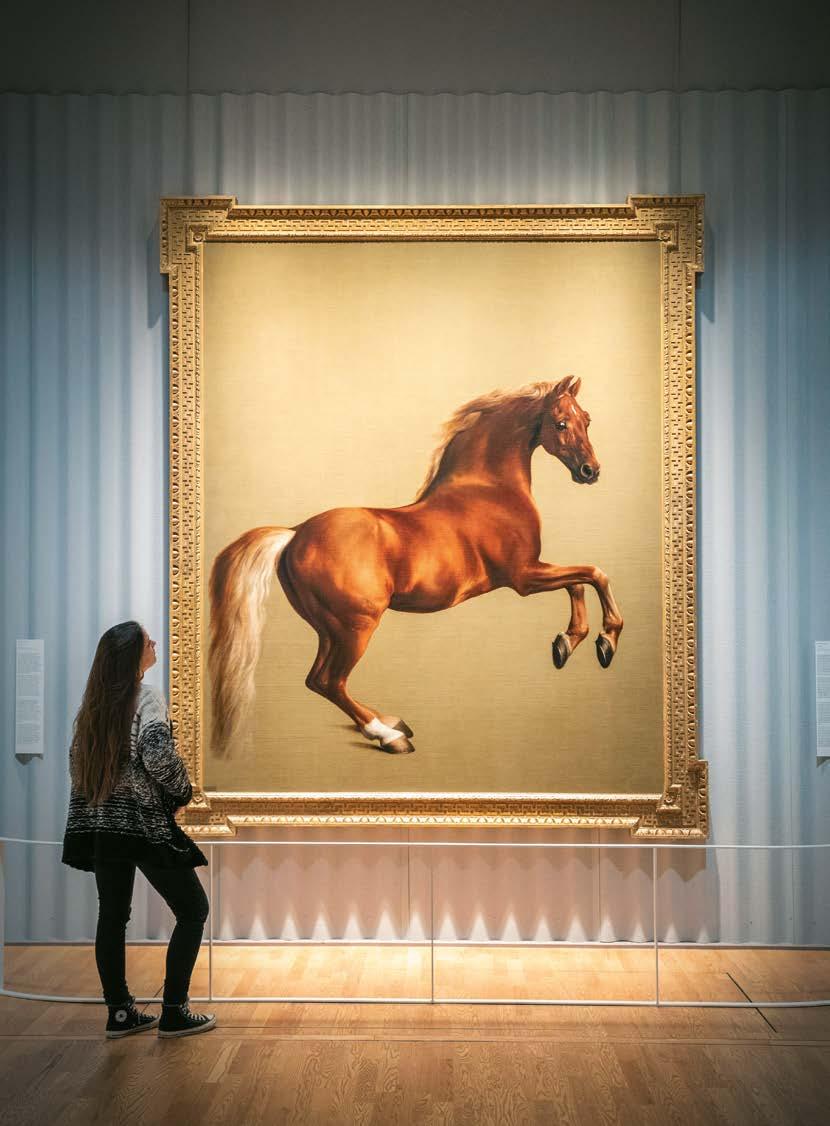
11 minute read
ART
ART DIARY SPRING 2020
George Stubbs The Man, the Horse, the Obsession
Advertisement
The exhibition focuses on a significant period in Stubbs’ career: the 1750s and 1760s. During this period, Stubbs quickly developed to become the leading horse painter in his country. The horse was a status symbol and wealthy owners want ed portraits of their swiftest and finest animals on their walls. Although Stubbs also painted people and numerous other animal species, it was with his portraits of horses that he estab lished his distinctive position as an artist. What made Stubbs’s portraits of horses unique was his ability to express the character of the animal as well as portray its physical presence. The portrait of the thoroughbred Blank is an exceptionally lively example. George Stubbs knew like no other how to capture both the physical attributes of a horse and its character. An in-depth study of the horse’s anatomy, for which the artist dissected the animals himself, laid the foundations for his success.
till June 1 Mauritshuis, The Hague, www.mauritshuis.nl
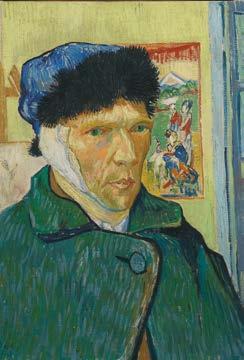
Vincent van Gogh, Selfportrait,1889 Caravaggio-Bernini. Baroque in Rome

Caravaggio-Bernini. Baroque in Rome In the first decades of the 17th century, a new generation of ambitious artists led by the brilliant painter Caravaggio and sculp tor Bernini shook the eternal city of Rome from its slumber. They introduced a new language to art that dispensed with elegance and incited the emotions. This was Baroque,

Helene Schjerfbeck, Selfportrait, 1915 a spectacular artistic style charged with drama, dynamism and bravura, which sparked intimate collaborations between painting, sculpture and architecture. This was a revo lution in Western art, one that started in Rome and resonated throughout Europe. Caravaggio-Bernini. Baroque in Rome is an exhibition of more than 70 masterpieces by Caravaggio, Bernini and their contemporaries. The paintings and sculptures are on loan to the Rijksmuseum from museums and private collections around the world.
till June 7 Rijksmuseum, Philips Wing, Amsterdam www.rijksmuseum.nl
In the Picture
People throughout the world recognize Vincent van Gogh – the man with the red beard and intense expression. Our image of the artist has been primarily shaped by his selfportraits. In the 19th century, painters made self-portraits to practice, experiment, or to set out their identity. They also made por traits of one other, often as a token of friendship. The spring exhibition In the Picture tells stories about identity and image, in 75 portraits.
This Is Surrealism! In 1916, a group of poets and artists in Zurich turned against academism and all common beliefs about culture. Their views formed the breeding ground from which surrealism originated in 1924. in response to the atrocities caused by World War I, the surrealists rejected ratio and everything that is common. Instead, they wanted to make art that was contrary, irrational and shocking. To achieve this, they came up with all sorts of games and techniques that stimulated chance and breathed new life into existing methods such as collage. The exhibition offers a comprehensive overview of top surrealist artists, with 193 pieces by 33 artists, within nine principal themes – with key works by Salvador Dalí, René Magritte, André Breton, Marcel Duchamp, Marcel Duchamp, Man Ray, Max Ernst, Miró and many other artists.

May 1 - August 30 Cobra Museum, Amstelveen www.cobra-museum.nl
What Will the Neighbors Say?
The Groninger Museum harbors an extensive, unique collection of contemporary photography. The exhibition What Will the Neighbors Say? showcases a wide selection of work by leading photographers from the Netherlands and elsewhere from the last 50 years. The work on view ranges from Diane Arbus’s and Larry Clark’s 1970s documentary photography, through Anton Corbijn’s and Catherine Opie’s portraits and Inez van Lamsweerde’s fashion work of the 1980s and 1990s, to Ruud van Empel’s and David LaChapelle’s staged scenes from the past decade. The photographs address themes such as diversity, artificiality and identity and pose an overarching question: why do we increasingly look at ourselves through the imaginary lens of another?
till August 30 Groninger Museum, Groningen www.groningermuseum.nl
Nam June Paik The Future Is Now In collaboration with Tate Modern and San Francisco Museum of Modern Art, the Stedelijk Museum presents a major retrospective of Nam June Paik, one of the most visionary and influential pioneers of early video art. Paik’s multidisciplinary, radical, experimental and playful work continues to inspire a new generation of artists. Born in South Korea, Nam June Paik (1932, Inez van Lamsweerde, Frederique and Sasha

Korea-USA, 2006) grew up in Japan, studied music in Germany and collaborated in Fluxus, an international network of avantgarde artists. Paik predicted the power of mass media to shape our lives and introduced the term ‘electronic superhighway’ to foretell the future of communication in an internet age. Paik erased the boundaries between art and technology, between East and West, and investigated technology’s impact on globalization and everyday life.
March 14 - August 23 Stedelijk Museum, Amsterdam www.stedelijk.nl
On Earth – Imaging, Technology and the Natural World
Photography enables us to observe the world and the effects of our existence in it. It can be used to document, eternalize and motivate events. Photography has also testified to the paradoxical relationship between man, nature and technology. As we use contemporary technologies to document and question our relationship with the natural world, we increasingly experience this world through the very same technologies used. This exhibition unites the work of 27 contemporary artists who use innovative visual techniques to reflect on the evolving relationship between humans and nature. Besides photography, the artists make use of installation, sculpture, in-game photography and video. Their various visual approaches diverge and converge throughout the exhibition. These artists show they both seek to explore and reunite our technological, socio-economical, spiritual and political connection with the world.
March 20 - June 10 Foam Photography Museum, Amsterdam www.foam.org
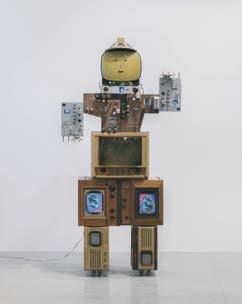
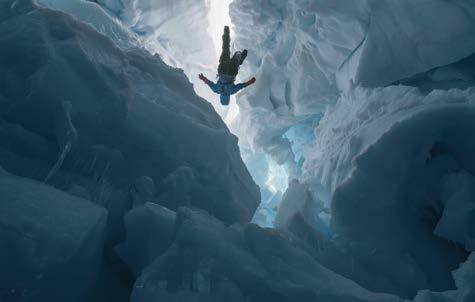

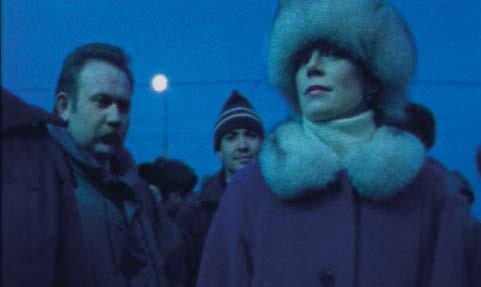
Bust of King William III, 1695-1700
Chantal Akerman, Dest au bord de la fiction,1995
Royal Blue
A unique find and a moving love story. This describes the purchase of two Royal Delft (or Delftware) flower vases in the shape of the royal couple William III and Mary II. In 2015, these two lovers – after having been separated from one another in private collections for 40 years – were reunited at the Kunstmuseum Den Haag. William and Mary were known for their splendid collection of Delftware with which they decorated their palaces in the Netherlands and England. From pyramid-shaped tulip vases many meters tall to flowerpots and serving dishes for preserves: in the late 17th century the most beautiful and technically refined earthenware was created for them by the potteries in Delft. The exhibition Royal Blue is organized in conjunction with Het Loo Palace and will bring together the very best showpieces from the Rijksmuseum,
Pablo Picasso, Women at their toilette,1971 Museum Prinsenhof Delft and numerous European collections.
March 21 - August 16 Kunstmuseum, The Hague www.kunstmuseum.nl
Chantal Akerman Passages This spring, Eye Filmmuseum is presenting a major solo exhibition of work by Chantal Akerman. Akerman was one of the first film directors who made the switch to visual art. She rose to fame in the 1970s as a feminist avant-garde filmmaker, and midway through the 1990s she discovered the possibilities of the art gallery. Much of Chantal Akerman’s pioneering work testifies to her avant-garde approach to the medium she employs. Fea tures of her distinctive personal style are long shots, frontal camera positioning and wide frames, enabling her to put forward a new

interpretation of time and space. Akerman’s works embody history, memories, lives that seem normal but are not. They display an “al most tactile sense of what it is like to observe from a respectful distance, the people and places they record”. The exhibition features eight of Akerman’s film installations. In addition to D’Est, they include a.o. Woman Sitting after a Killing (2001), Tombée de nuit sur Shanghai (2007- 2008) and her final work NOW (2015).
March 21 - May 31 Eye Film Museum, Amsterdam www.eyefilm.nl
Extra Large – Tapestries From Picasso And Le Corbusier To Louise Bourgeois For the first time in the Netherlands, Kunsthal Rotterdam is presenting a large-scale retrospective of imposing tapestries based on designs by renowned artists like Pablo Picasso, Le Corbusier, Miró, Vasarely and Louise Bourgeois. The exhibition focuses on a period of 100 years, with tapestries made directly after the First World War up until now, and reveals a virtually unknown aspect in the bodies of work of many modern and contemporary artists. They have been using the age-old weaving technique as the point of departure for their textile art while constantly reinterpreting it. With their combination of artistic finesse and extraordinary craftsman ship, these meters-high, handwoven tapestries are of an unrivalled quality and a joy to behold, and show how surprisingly modern the traditional craft of weaving still is.
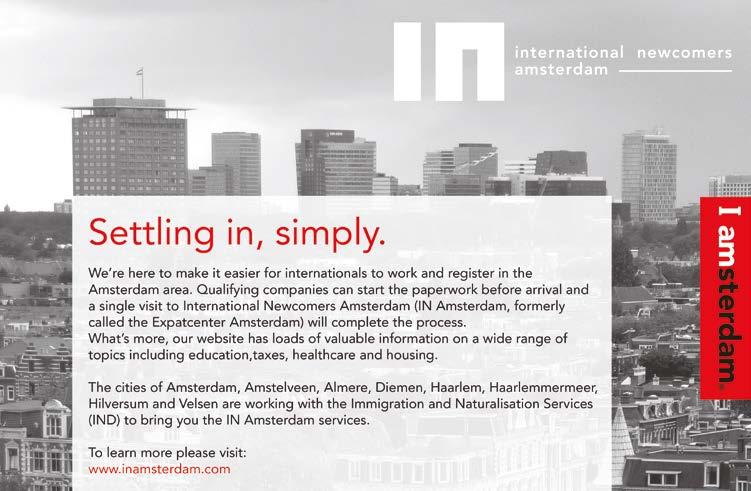
TAX | PAYROLL | ADMINISTRATION
Looking for help with your tax affairs ?
> Preparation of Dutch and US tax returns

> Administration for freelancers
> 30% ruling application
> Accounting for companies
> Payroll administration
> Company formation
> Tax advice
The Future Looks Bright
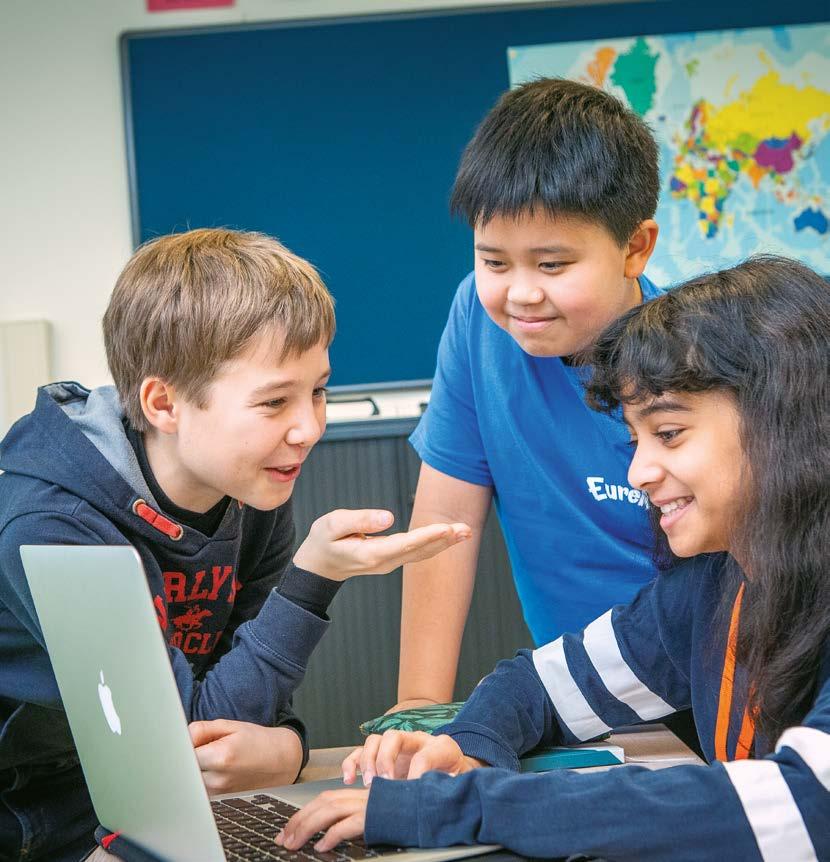
FOR INTERNATIONAL SCHOOL DELFT
Since the successful launch of the Primary school in 2014 on the TU campus, International School Delft (ISD) has entered a new phase in its development with the opening of a Secondary school campus in 2019.
By Jaap Mos W ith this addition, ISD is under way to becoming one of the few schools in the Netherlands to offer the full range of International Baccalaureate (IB) programmes. In early 2019, ISD was granted approval by the Ministry of Education to expand with a Secondary school to serve the growing demand for high-quality international secondary education in the Delft / The Hague region. Mr. Jaap Mos, the director of ISD Secondary, who has a long history of setting up international schools, tells us more. Looking back, how has the first year of ISD Secondary been? Challenging and rewarding. After the green light from the Ministry, we had five months to prepare the kickoff and get ready to welcome our first students. We were fortunate to have been offered an existing school building by the municipality of Delft. Within a matter of months, our team of specialists managed to convert the building into an attractive learning environment with all the facilities required for engaging inquiry-based learning in the spirit of the International Baccalaureate. The building is designed to allow for growth over the next three years and is very accessible by bike, public transport and car. Meanwhile, we are in the process of development for our new state-of-the-art school building, to be located on the TU Delft University campus, and in close proximity to our Primary school. We started the academic year in August with an enthusiastic and diverse group of students in the years MYP 1 and 2. It is very rewarding to see how our first group of students fosters a strong sense of community and truly considers themselves ‘pioneers’ and ‘ambassadors’ of the Secondary school. This positive spirit amongst our students, parents, and teachers has absolutely been a critical factor to the success of this year. Looking forward, how do you see the future for International School Delft? We are excited about the future of the school. The interest in our school is now rapidly growing, and this is reflected in the student enrolment for next academic year. With more international organisations settling in the Delft / The Hague region, we anticipate a further increase in the demand for international education. Together with our Primary school, it is our ambition to jointly develop the International School Delft into one single attractive and high-performing international school for students aged 4 to 18 years. We are fortunate to be closely connected with Delft University of Technology. This partnership is reflected in a variety of joint projects with the University, often focused on innovation, design and technology. This will be the cornerstone for the future development of ISD. It’s our mission to provide for “inspiring learning for a sustainable future”. Subjects such as technology, innovation, sustainability, history, and art are deeply embedded in our curriculum. The IB programme aims to develop well-rounded, inquiring, caring and future-oriented young people with a global mindset. In addition, it is important to us that our students actively participate in the Delft community, so that they are part of, and benefit from, its rich traditions whilst also contributing to its international character. International School Delft is a member of the association of Dutch International Schools, a network for professional and quality development of state-subsidised international schools in the Netherlands. In the academic year 2020-2021, ISD Secondary will offer MYP 1, 2 & 3. For information, and registration, please visit the school website at www.internationalschooldelft.com ‘The teachers and students in this school are understanding and caring, they don’t judge people and they help brighten up your day’ Jane van der Merwe, MYP2










